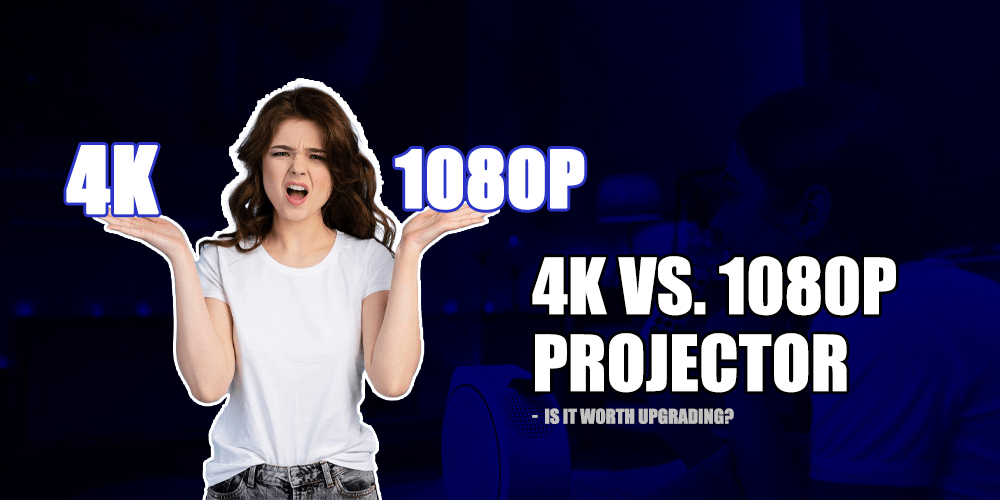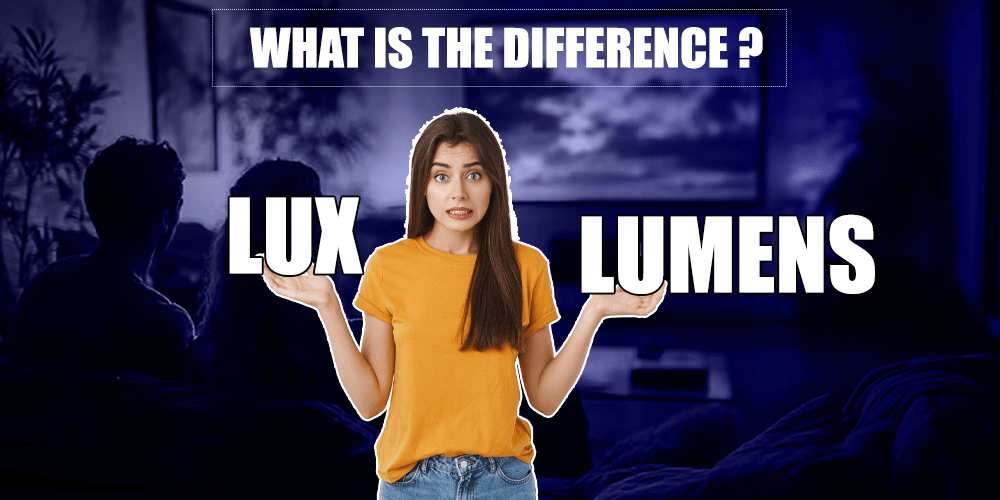In this article, we will elaborate on various vital points of 16:9 vs 16:10 projector screens, as it is confusing for most people to decide between these two.

Various technicalities are kept in mind whenever a user decides to buy a projector screen, such as size, material, flexibility, and screen gain. However, people rarely look at the aspect ratio format that a projector offers. That’s why this article exists.
It is very important to choose the best aspect ratio for a projector screen. You may have many choices, and the most common dilemma is choosing between 16:ó9 or 16:10 projectors.
When you consider a 16:9 aspect ratio, that means that for every 16 units of width, there are nine units of height. For 16:10, there are 10 units of height for every 16 units of width.
What is Aspect Ratio?
There are so many things to consider to get a perfect projector screen format, so it is mandatory to understand the aspect ratio and formats before making a choice.
To describe the aspect ratio in front of a layman, the aspect ratio is the shape of the image area of a projector screen that will be visible, while watching content. It is a fractional difference between the height and width of the video frame.
Aspect ratios range from 1:1, 4:3, 16:9, and 16:10. Each aspect ratio is completely different from the other. When you consider a 4:3 aspect ratio, that means that for every four units of width, there are three units of height.
Similarly, a 1:1 aspect ratio means that for every 1 unit of width, there is 1 unit of height. A 16:9 aspect ratio means that for every 16 units of width, there are nine units of height. For 16:10, there are 10 units of height for every 16 units of width.

Different Types of Formats
There are different formats in aspect ratio, and it is not limited to just one format. Similarly, each format also varies in usage.
The 1:1 aspect ratio is not a popular format due to its square screen, but it is primarily useful in commercial research and educational institutions.
The 4:3 is one popular aspect ratio that is useful in the original TV format. Though it has limited usage in the entertainment sector, it is extensively used in educational institutes and offices.
HDTV format, or 16:9 aspect ratio, is the most used format in the current generation. It has become an inevitable choice for users who get a flat TV or projector. Even most movie DVDs and Blu-Rays also opt for this aspect ratio in a wider range.
With a 16:9 aspect ratio, there is also a 16:10 aspect ratio format that is not as popular as 16:9, but it has many perks. This format is dedicated to businesses that require a widescreen view or a widescreen PC.
These aren’t the only formats; there are many more to come in the market as modern technology grows with every passing day.

Aspect Ratios Of Standard Projectors
Most people who have a concern with delivering lectures in the classroom or for presentation purposes find a 4:3 aspect ratio as the perfect one for them. However, as the industry moves forward day by day, the aspect ratio has also moved from 4:3 to 16:9 or 16:10. These other options are far better than the 4:3 format.
16:9 vs 16:10 Projector Screen: What are these screens actually?
What Is a 16:9 Projector Screen?
The most popular aspect ratio in today’s world is 16:9, without any doubt. It is widely popular as HDTV or high-definition format as it offers International Standard HDTV format.
The major reason for its popularity is that it acts as a sweet spot between the 35mm UK widescreen standard and the US widescreen standard. It also acts as a bridge between European widescreen standards and UK standards.
The dimension produced on-screen is optimal and highly favorable, and many users prefer it for home theater setups to watch movies and games.
It won’t rob your perfect and superior visual experience by compromising the performance and image quality. Most binge-watchers, as well as gamers, prefer this format due to the depth and visual appeal that no other projector screen offers.
The dimension produced on-screen is optimal and highly favorable, and many users prefer it for home theatre setups to watch movies and games. It won’t rob your perfect and superior visual experience by compromising the performance and image quality. Most binge-watchers, as well as gamers, prefer this format due to the depth and visual appeal that no other projector screen offers.
You will even get more visual clarity while playing 4K or HD format content on a large screen as compared to 16:10 without any kind of distortion. So, it is a perfect ratio for home theater experience for entertainment and gaming.
However, you won’t be able to utilize it for presentation purposes as it would not provide the professional look and feel that you would get in a 16:10 format. Apart from a high-definition resolution projector, you won’t find it in any other native-resolution projector with WXGA, WQXGA, or WQUXGA.
What Is a 16:10 Projector Screen?
The 16:10 is a widescreen format that is also known as the 8:5 aspect ratio and is highly popular in terms of WXGA, WUXGA, or the same kind of resolution.
In past years, it was the most popular aspect ratio in the widescreen segment, with a 4:3 legendary format in market share. But then it became the favorite choice for all kinds of purposes. However, this popularity didn’t last for a long time, as 16:9 stole the whole market with its better capabilities.
Though these are not as popular as 16:9, they are still considered the best choice for business presentations and widescreen viewing experiences. It offers a widescreen format, but the clarity of the text is maintained precisely without ruining data texture.
With this amazing 16:10 projector screen format, you can easily pair up with WXGA, WXGA+, WUXGA, WQUXGA, WSXGA, and WQXGA native resolution. Though there are a lot of dissimilarities between these two aspect ratios, ultimately, they perform the same function.
Check out our guide about Projector Resolution
Which Aspect Ratio Will Be Right for You?
Before deciding which one is good to go, it is important to know that you can watch 16:9 content on a 16:10 display or other aspect ratios. But black bars will appear on the screen, at the top, bottom, and even on the sides. It usually happens in case the resolution of the material you’re watching on the projector doesn’t match the resolution of the projector.
If you want to avoid those blurry or black bars, all you need a projector screen that matches the aspect ratio of the material. For this purpose, you need to consider three things when deciding about what format or projector screen to get. These factors are mentioned below:
- Projected content format (video)
- Projector’s format
- Viewing surface format (screen)
The clarity in resolution won’t be compromised anymore if you‚ All keep these factors in mind. If there is variation in any of these, you’ll again face those black bars on the screen. If those black bars do not bother you, then you do not need to choose any specific aspect ratio. You can go with any. But if you’re more perfection conscious, then choosing the best option will be a great option.
Top 3 16:9 Recommended Screens
- Elite Screens Manual B 100-INCH Manual Pull Down Projector Screen.
- Silver Ticket Products STR Series 6 Piece.
- Projector Screen with Stand, Upgraded 3 Layers PVC 120 inch 4K HD 16:9
Top 3 16:10 Recommended Screens
- Silver Ticket Products STR Series 6 Piece Home Theater
- Akia Screens 100-inch Projector Screen Pull Down Manual B 16:10
FAQs: Frequently Asked Questions
What resolution is 16×10?
16:10 aspect ratio resolutions: 1280×800, 1440×900, 1680×1050, 1920×1200, and 2560×1600.
What resolution is 16×9?
1920 x 1080 (16:9), this is the High-definition standard, referred to as 1080i/1080p.
Is 16×9 a widescreen?
16:9 is the standard widescreen aspect ratio. It’s also the aspect ratio that smartphones and tablets record in, as well as DSLRs and most camcorders.
Which is the highest resolution?
8K resolution refers to an image or display resolution with a width of approximately 8,000 pixels. 8K UHD (7680 ó 4320)¬ is the highest resolution defined in the Rec. 2020 (UHDTV) standard.
Conclusion: So now you know the difference between 16:9 Vs 16:10 Projector Screen
It can be overwhelming to figure out what you need when you plan to set up a home theater system. You might not be aware of the amazing options already available on the market. All you need to do is choose a projector screen that can offer great image quality and then match it with the projector. You’ll need a screen that is 16:9 if you are planning to use a 16:9 aspect ratio.
Most projectors come with width as an option to choose from when purchasing a used or new one. So be careful while checking out these options before making a final decision about the size that best fits your needs.
Choosing between 16:9 and 16:10 is all about the formats of the viewing surface and materials. If you want to enjoy cinematic or gaming content, the perfect option for you will be a 16:9 aspect ratio.
However, in the case of PCs or computer tablets having WUXGA, WGA, or similar kinds of resolutions, then 16:10 would be the ideal choice.


